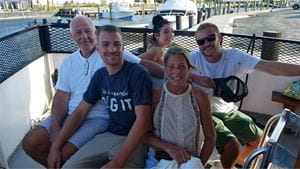
Life was moving along at its usual quick pace for Gayle Mourgides in late 2022. She and her husband, both in their 60s, were spending 6 months a year in the Rochester area and the other 6 months of the year managing their restaurant Olives in the Outer Banks of North Carolina.
Between overseeing their restaurant and homes in both states, and maintaining relationships with their seven children, the days moved by quickly for the couple.
An active walker and business owner, Gayle walked several miles a day in addition to working as a waitress at her restaurants. She ate a clean Mediterranean diet and visited her primary care provider for a yearly physical exam.
“Even though you’re doing everything right, sometimes things happen,” Gayle said.
See How Our Surgical Oncology Team Can Help You
In early 2023, Gayle spotted a mole that began changing on her leg. Following several tests and a meeting with her oncologist, she ended up making her first appointment with a dermatologist with Rochester Regional Health.
“I got right in,” Gayle said. “When he determined it was cancerous, he went out of his way to reach me because my voicemail was full. He was wonderful and just outstanding.”
Following the diagnosis, the dermatologist immediately put Gayle in touch with Ankit Patel, MD, a surgical oncologist. During her meeting with Dr. Patel, she said he was very thorough and took the time to answer every question she had.
“He wanted to talk with me about everything,” Gayle said. “Doctors are usually very efficient, but he stood out because he wanted to make sure I had every single question answered and wanted to know how I was feeling.”
Following the consultation with Dr. Patel, Gayle had the cancer removed from her leg and went through a brief recovery period.
She now meets with her dermatologist twice a year to ensure everything looks good from a dermatology perspective. Dr. Patel will also be meeting with her regularly for the next 2 years to ensure the lymph nodes in her leg are not inflamed.
“I felt in great hands with both of these doctors,” Gayle said.
All of Gayle’s doctors work together as a part of a multidisciplinary team to ensure patients like Gayle have the best possible care by having providers with different specialties look at the case.
At Rochester Regional Health, providers spend as much as possible with each patient to gather all of the information and context they need, and are then able to tap into the broad network of Rochester Regional Health services and specialties as they are needed.
From primary care to dermatology to surgical oncology, the collaborative approach taken by Gayle’s providers with Rochester Regional Health brought in all of the necessary expertise that she needed to receive the best possible care at every step in her cancer journey.
The comprehensive confidence these doctors give Gayle is substantial.
“Especially at a time like this when your time changes so rapidly from a cancer diagnosis to having melanoma, you need to empower yourself with people who love what they do and make you feel like you’re not another face who comes into the office,” Gayle said. “You need to feel like you are an individual who needs their expertise and guidance to get through the situation as positively as you can.”
Gayle was able to find the treatment she needed because she was able to spot the changes on the mole on her leg before the melanoma developed any further.
Since skin cancer is the most common type of cancer in the United States, regular skin cancer screenings are an important part of cancer prevention. You can look at your skin for new moles, changes to existing moles or birthmarks, or have a provider screen for them. Some of these changes might include a different color, size, shape, or texture.
Dermatologists use the ‘ABCDE’ acronym to remember the changes for melanoma:
Asymmetry (one half of the mole does not look like the other)
Border irregularity (edges are jagged instead of smooth)
Color variation (shades of black, red, gray, or blue)
Diameter (greater than a pencil eraser)
Evolution (change over time or symptoms)
If you see a change in an area of your skin that worries you, reach out to your primary care provider or a dermatologist. Don’t hesitate to ask; their expertise can make a big difference.
Another important thing you can do for melanoma prevention is protecting yourself from the sun. This means limiting sun exposure within peak hours of the day (typically 11am to 4pm), wearing broad spectrum sunscreen (SPF 30 and over), and reapplying sunscreen every 2 hours.